This recipe is for low-sugar, addictively delicious strawberry jam made without any added pectin. This jam is thick and chewy, with an intense strawberry flavor and rich burgundy color. A true artisanal delight with a very long family history, you won't find anything like it in a store. It goes so well with Dutch babies, English muffins, or pancakes.
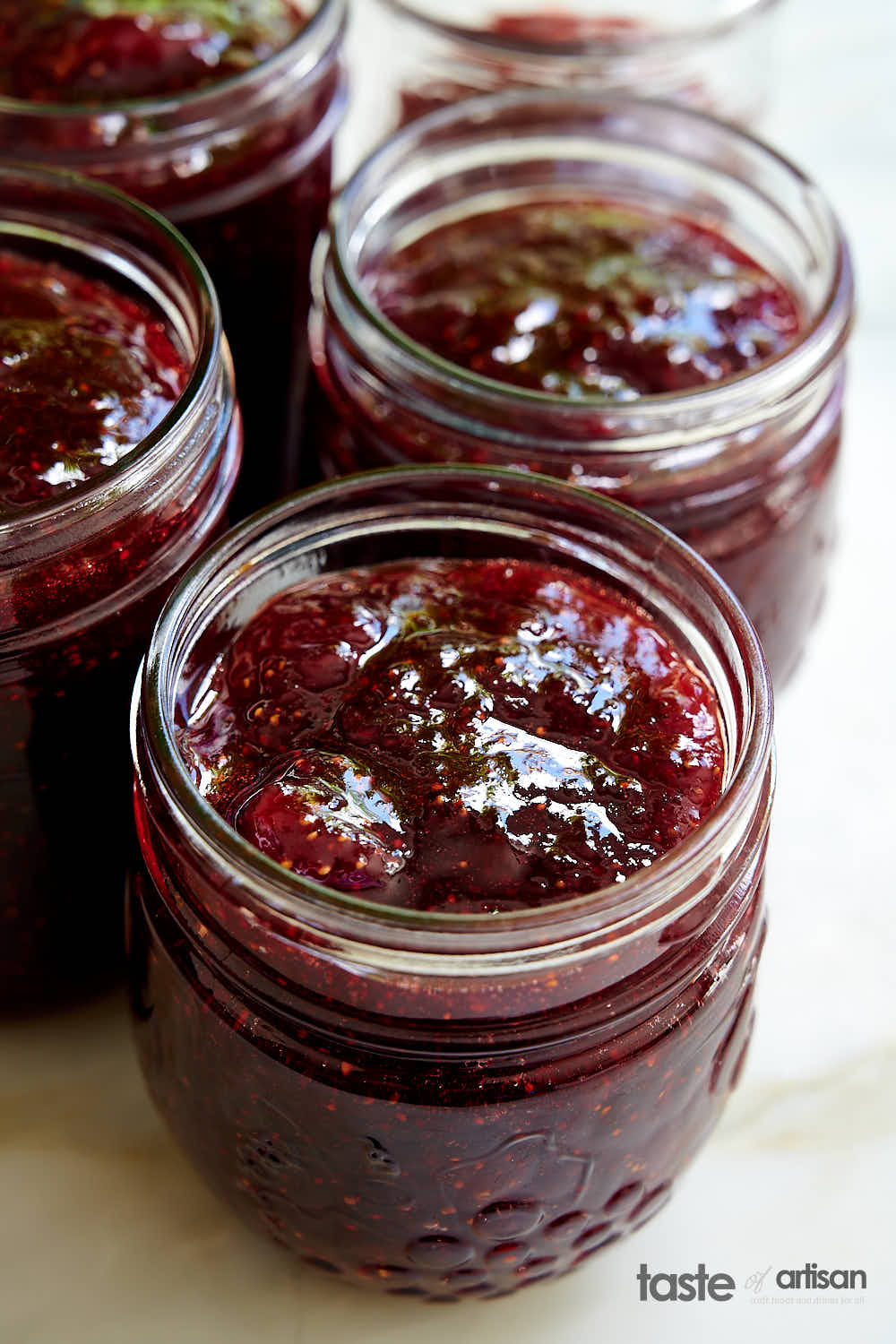
Many books instruct to use pectin when making strawberry jam. They say that pectin will make strawberry jam thicken faster, the color will be light and that strawberries will hold their shape. What they don't tell you is that pectin changes the texture and the taste of strawberry jam. In my opinion, strawberry jam made with pectin tastes more like strawberry-flavored jello. I don't like it at all. Commercial jam makers love using pectin as it increases their yields but that comes at the expense of the taste and texture. Do we really want to copy commercial jam makers? At home, you can make the real strawberry jam that will taste a thousand times better.
I've been making strawberry jam this way for years and that's even how my grandparents and great-grandparents used to make it. Let me tell you, I wouldn't make it any other way as it's exceptionally delicious. That's what true strawberry jam tastes like. Made this way, the jam comes out thick, jammy, chewy and ridiculously good. It's a little darker than if you used pectin and thickened it within 10 minutes, capturing all that unnecessary water inside, but who cares? I love the darker, rich burgundy color of the strawberry jam that was cooked a little longer. Its flavor is more intense, akin to how beef's flavor becomes more intense after dry aging. And guess what, the strawberries never disintegrate and hold their shape just fine.
Strawberries
What strawberries you use to make strawberry jam makes a big difference. Pick the tastiest varity you have access to. The more flavor and taste your strawberries have, the better your strawberry jam will taste.
In France, Mara Des Bois variety is the most popular for jam making. These strawberries are a cross between wild and commercial strawberries. They are larger than wild strawberries but just as intensely flavorful. The have a perfect balance of sweet and tart - a strawberry that you don't just eat, you savor it. I just started growing these strawberries in my garden and plan on making jam with them once my harvest is big enough.
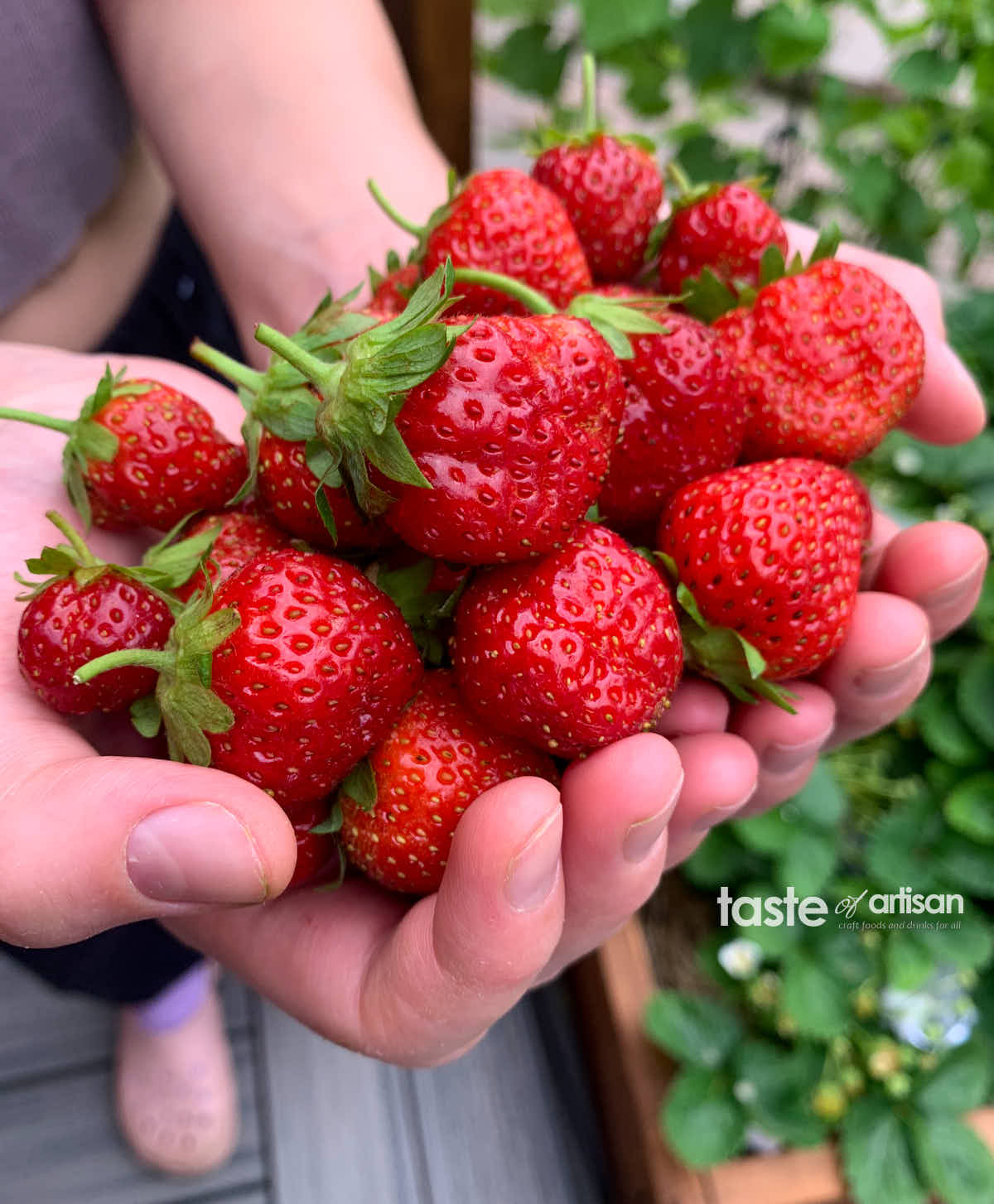
Sugar to strawberry ratio
The only thing I changed to the family recipe is to reduce sugar from 1:1 ratio to just 40%. One pound of sugar to one pound of strawberries is way too sweet for me. I experimented with dropping the ratio of sugar to 60%, 50% and then 40% and 30%, and realized that 40% was just perfect.
Batch size and jam pan size
You would think that with this low sugar content the jam would have a hard time thickening without pectin but it does just fine. The trick is to use a large, preferably copper jam pan and not to overload it. In my 16.75 Qt, 11" bottom jam pan I can prepare 5 lbs of strawberries (plus sugar) in about 35-40 minutes. A 2-3 lb batch of strawberry jam will be ready in about 15-20 minutes or so. If you are going to use a smaller pan, reduce the batch size accordingly. In my 16.75 Qt jam pan I can make batches as big as 6 lbs which would take about 50 minutes to cook but I try to keep my jam batches at 5 lbs or less, depending on how much fruit and berries and I need to process.
As well, if you want your jam to be lighter in color with firmer fruit/berries - decrease your batch size. Two-three pound batch size would be recommended.
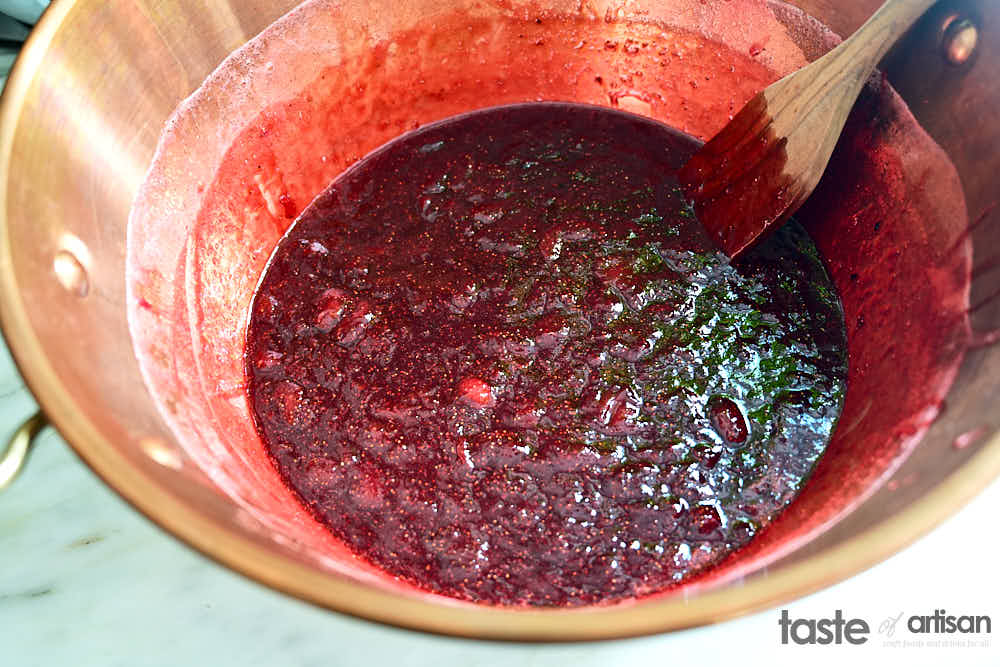
Making strawberry jam
Making strawberry jam begins with the process called maceration. Macerating is a technique that softens fresh fruit and draws out its natural juices, in which the fruit then soaks, sort of like marinating. It draws a lot of liquid out of the strawberries. This is extremely important as that liquid can be easily evaporated given high enough heat. If the liquid is inside the strawberries when you begin to apply heat, that won't be so easy. You will have to cook the jam longer which will impact the shape and the firmness of the fruit. I leave my strawberries to macerate overnight but a few hours will do.
Once macerating is done, we begin cooking our jam. Ideally, you'd want to evaporate excess water as quickly as possible. Hence, I begin cooking over medium-high heat.
Vigorous boiling causes a lot of foaming and so it's important to have a jam pan or a pot with tall walls, at least 7 inches, and not to overload the pan. Removing the foam is not strictly necessary but I like removing it for two reasons. First, it will leave white streaks on the surface of the jam, though most will go away eventually. Secondly, that foam is so delicious. I, as a kid, loved to eat it when my grandparents skimmed it off the boiling jam. I do it too and my kids love eating it. It's like a family tradition.
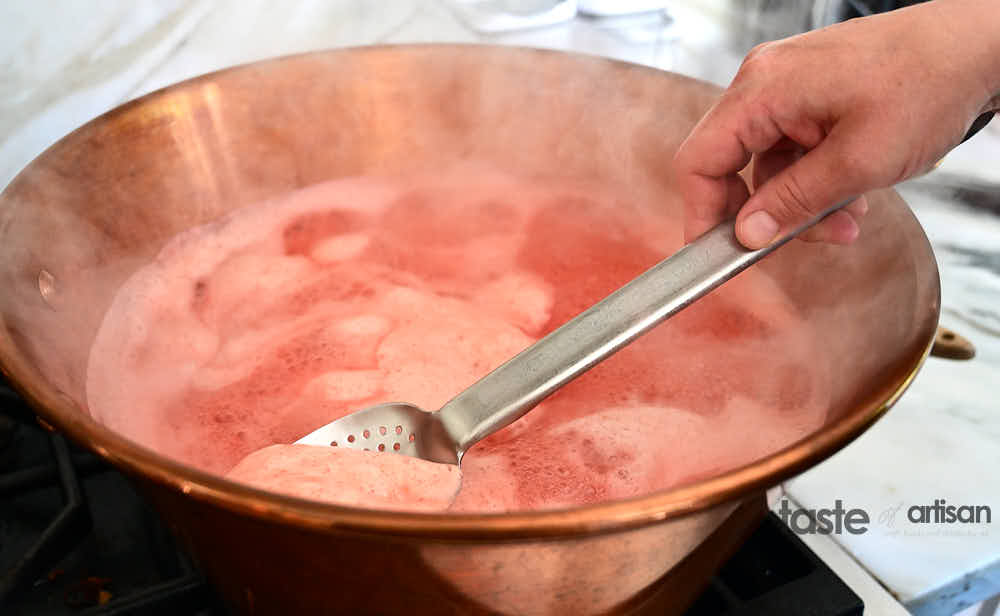
While the jam is boiling, keep stirring it every couple of minutes, scraping the bottom with a flat wooden spatula. While there is still a lot of water in the jam, there won't be any sticking at the bottom.
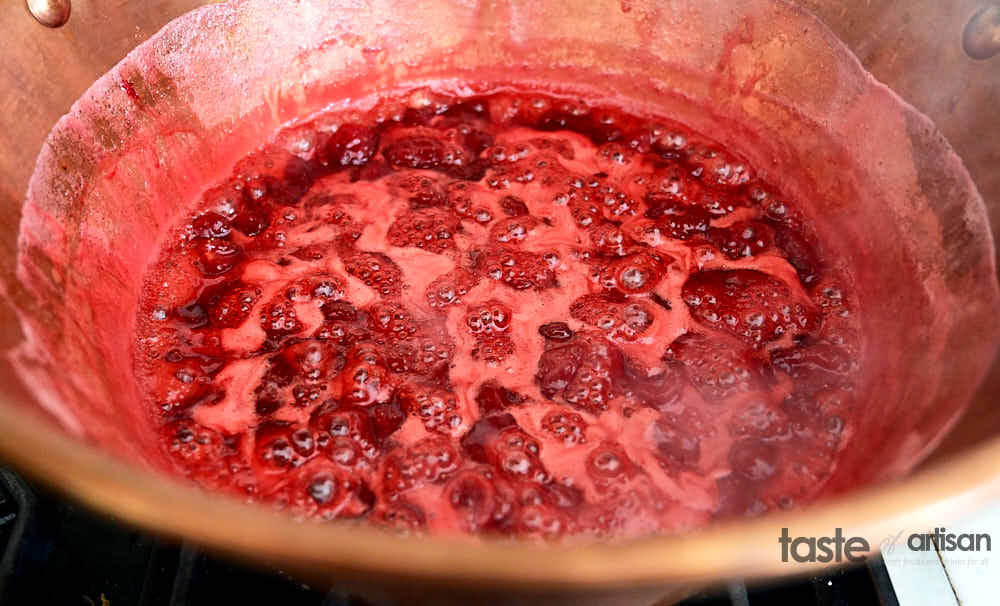
However, as the water boils off and the jam thickens and becomes darker, you will notice a slight sticking of the jam to the bottom of the pan when you run the spatula across the bottom of the pan.
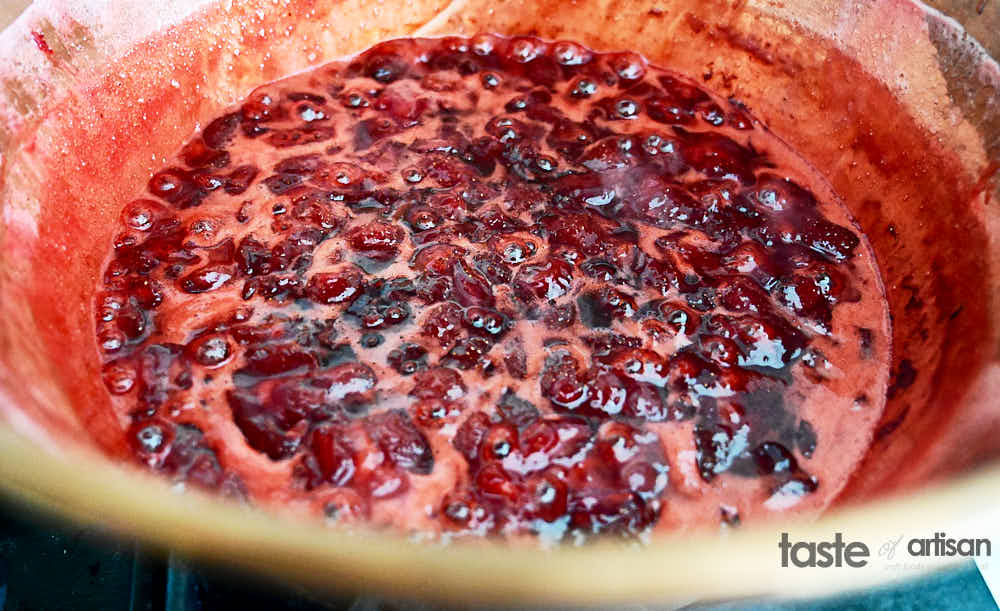
Immediately turn the heat down to low and continue cooking constantly stirring the jam, thoroughly scraping the bottom.
Continue cooking until the jam thickens to the point where if you run the spatula quickly from one side to the other across the bottom of the pot, you can observe as long as a 6-7 inch long gap before it starts to quickly fill back up. This will make a thick jam that is not runny when it cools down but is easily spreadable.
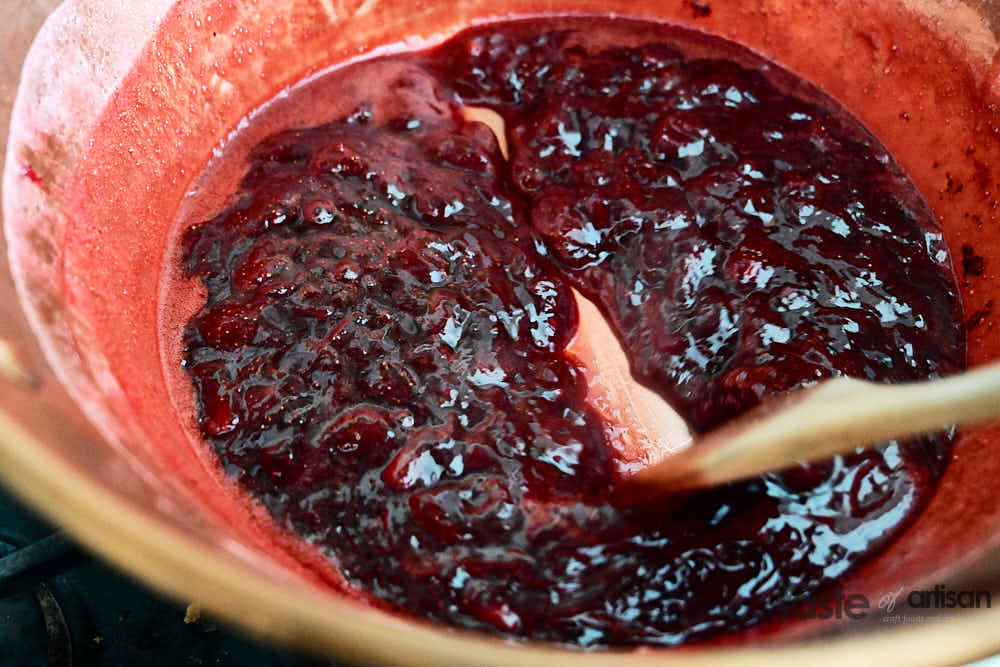
Canning strawberry jam
When canned, this strawberry jam will keep its freshness for well over a year as it contains less water than its pectin sibling. Two and even three years are totally reasonable based on my experience if you keep it in a cool, dry, dark place. Canning is the best way to store this jam. Once opened, store the jars in a fridge.
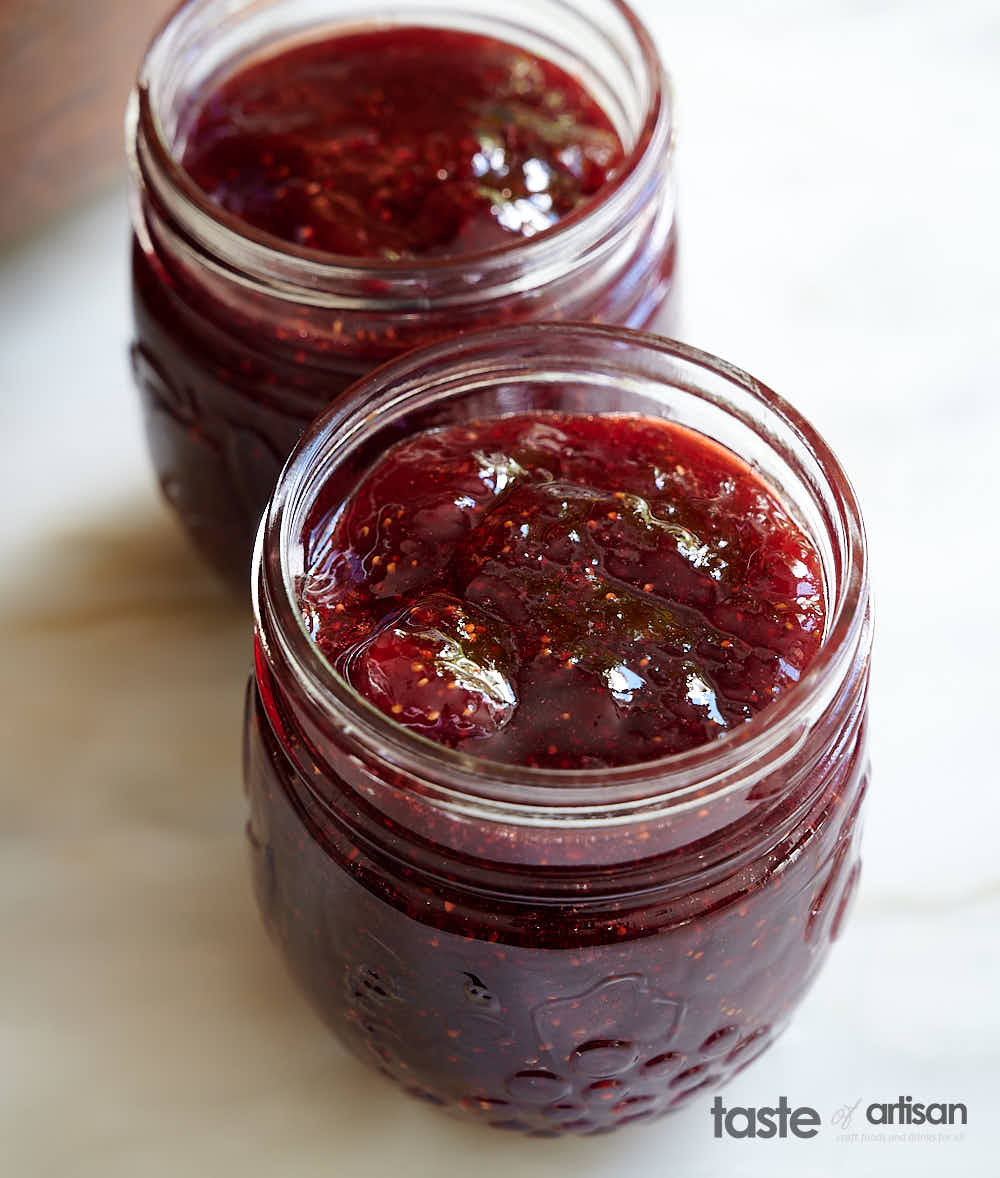
I fill hot, sterilized jars with hot jam and process them in a water bath canner for 10 minutes. Technically, 5 minutes should be enough when processing in sterilized jars and you can use clean, unsterilized jars if processing for 10 minutes. But I've had an odd jar that did not seem to create a proper seal after 5 minutes of processing so I now use 10 minutes and it's been a success.
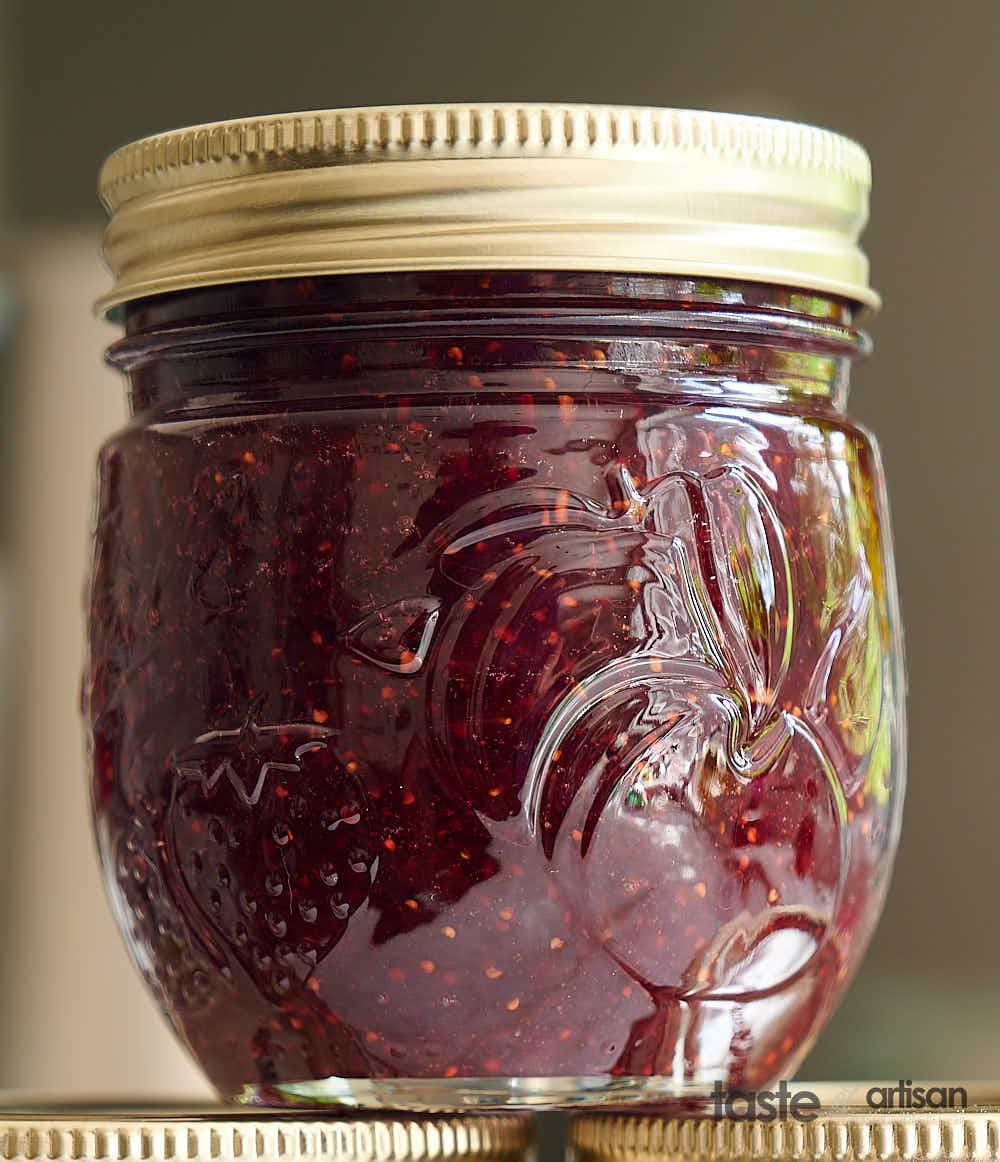
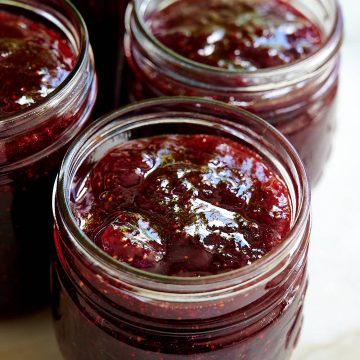
Homemade Strawberry Jam
Ingredients
- 5 lbs strawberries rinsed, cored and halved
- 2 lbs white sugar
- 3 Tbsp lemon juice
Instructions
- Place the halved strawberries in a bowl. Add the sugar, lemon juice, and mix well. Refrigerate overnight or macerate for a few hours at room temperature.
- Transfer strawberries with the juices to a jam pan. Bring to a boil and cook over medium-high heat stirring every few minutes until the jam begins to thicken and starts to stick to the bottom of the pan slightly. Skim off the white foam.
- Once the jam starts to stick to the bottom of the pan, lower the heat to low and continue cooking constantly stirring and scraping the bottom of the pan very well. Cook until such time as when you run the spatula quickly from one side to the other across the bottom of the pot, you can observe as long as a 6-7 inch long gap before it starts to fill back up.
- Turn off the heat and let the jam rest.
- Sterilize mason jars and the lids with bands.
- Fill the hot jars with the jam using a clean ladle and a canning funnel, leaving a 1/2" headspace.
- Wipe the rims of the jars, put on the lids and the bands. Tighten the bands finger-tight.
- Process in a water bath canner for 10 minutes (assuming 0 - 1,000 feet above sea level), making sure there is at least an inch of water above the lids.
- After processing, remove the jars from the canner and let them cool down. Check the seals, then move to a dry, cool and dark place for storage. This strawberry jam, if properly sealed, will have a long shelf life, up to 3 years before you will notice a loss of taste quality.
Special Equipment
- Five 8-oz mason jars with lids and bands


pam says
hi, i have no access to fresh strawberries, can i use frozen instead? i have a 2lb bag of frozen strawberry in my freezer for a year now and i don't know what to do about it except make strawberry margarita (haha)
Victor @ Taste of Artisan says
Pam, I've never made jam with frozen berries, but I've made plenty of pie filling and cakes with them. It works great. I don't see why it won't work to make jam. Thawed strawberries may not have the same texture and may not hold shape as well as fresh berries, but I am sure the taste will be there. Good luck!
Nina says
Thank you for sharing. You jam looks so yummy!
I wanted to ask if there was a typo in your recipe? It seems to all be in pounds.
Should it be cups?
Ingredients
*5 lbs strawberries rinsed, cored and halved
*2 lbs white sugar
*3 Tbsp lemon juice
Victor @ Taste of Artisan says
Hi Nina, no, it's in pounds. Two cups of strawberries will make a very small amount of jam, unless that's what you want. Good luck!
Hanre says
Thank you for this, mist recipes wants you to add pectin and 1:1 ratio sugar which is crazy. I was scared to make strawberry jam because of this. Will this recipe also work with other fruit and berries?
Victor @ Taste of Artisan says
Will certainly do. I made a lot of jam this year - will have to post my recipes - mostly peach, apricot, strawberry and various plums. They all came out really, really good. I struggled with plum jams before, hence didn't make it often, but this year I cooked them less and they came out fabulous. This year, I made them with various types of plums, it's quite interesting how different some of them taste. In general, yes, this recipe will work with other fruit and berries but you have to pay attention to natural pectin content. E.g. plums. they have a ton of pectin so you must cook them less or else the jam will have a stiff, head cheese like consistency. For my first batch of plum jam I used a cold plate to check for doneness, later I'd just eyeball it. The rest of the ingredients/ratios I kept the same and they worked great. Peach and apricot behave the same way. Apple - same everything except much less cooking as apples have a ton of pectin too.
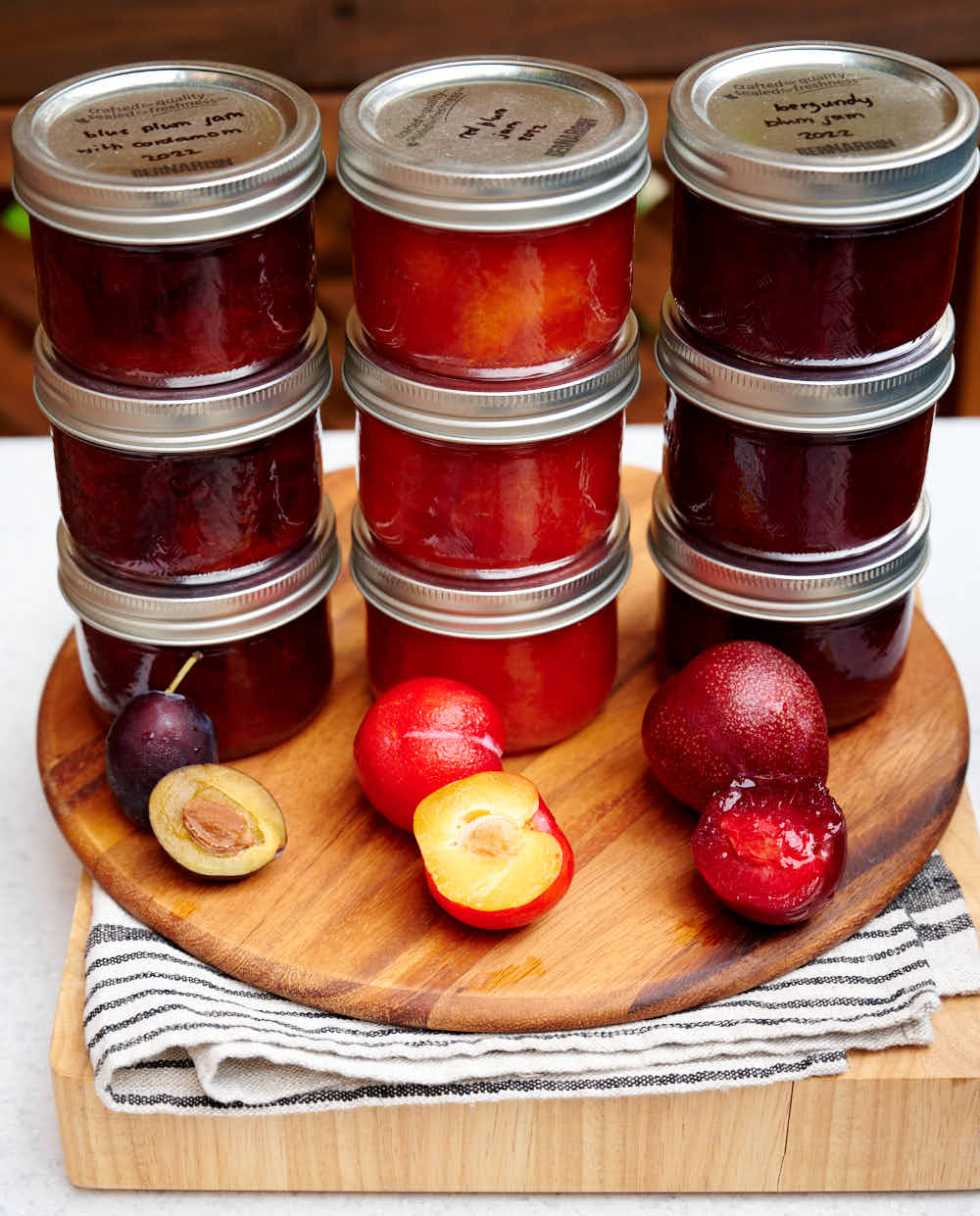
Michael says
Victor, I do not have access to good strawberries. Would this method work for stone fruit, like peaches, or other berries? I can get great blueberries. Thanks!
Victor @ Taste of Artisan says
Michael, this method works great for peaches, plums, and apricots, I make a few jars of each every summer. I don't have a lot of experience with blueberries, I've only made jam with them twice, but it worked as well. Blueberries are naturally low in pectin, just like strawberries.
Cis says
Have you ever made Apricot Pineapple jam using canned crushed pineapple.?
Victor @ Taste of Artisan says
Hi Cis, no, I haven't, but I made a couple of batches of apricot jam last summer. Adding pineapple sounds like a great idea, I will try it this summer. I made cherry/orange jam last summer and it was a hit. Will be making more this summer.
John says
While I find this recipe good in general I have to object to several points. For a this isn't no pectin, it's just low pectin. Strawberries contain some pectin and the proof of this is in the fact your jam sets, which only a pectin network can cause. I in general agree on mass produced (supermarket style) jam haven't an unpleasant texture, but I disagree with your conclusion that the mere inclusion of added pectin is the cause of this. Commercial jams often use obscene amounts of added pectin in addition to gelatine or similar. On the other hand a small amount of added pectin, used in a controlled fashion, can greatly improve strawberry jam. Personally I find it an absolute crime to cook fresh fruit so long that the freshness and beautiful light colour is lost in favour of burnt Carmel flavours, and a little pectin, along with some lemon juice greatly reduces cooking times to avoid this. Never forget, pectin is just a natural compounds which occurs in fruit, not synthetic substance. You can extract pectin from green apples, or use a discarded lemon seeds and skins like a bouquet garni to add natural pectin
Victor @ Taste of Artisan says
John, thanks for your comments. I see your point on pectin, though it's so small in strawberries that it's almost negligible, so when I say no pectin I imply no pectin added. You may argue that I add some pectin by way of introducing lemon juice in the recipe, but again, it's negligible in lemon juice (as opposed lemon seeds). I add lemon juice for flavor/taste/safety primarily.
Thickening of jam can happen not just because of some level of pectin present but merely because of water content reduction especially given added sugar. My recipe works very well without adding pectin. No burnt caramel flavor or any other unwanted flavors here. None.
Commercial producers adding gelatin is something else, I am not even going there. I don't even buy jams like that.
I've experimented with adding a little bit of apples, goosberries and currants, but felt that the texture of the jam changed. There wasn't the same smoothenes, same 'fluidity' to it if you wish. That said, we all have different tastes. I love my strawberry jam made this way and those who tried it generally loved it too.